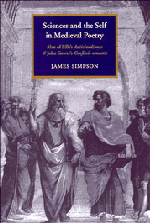 Sciences and the Self in Medieval Poetry
Sciences and the Self in Medieval Poetry Book contents
- Frontmatter
- Contents
- Acknowledgements
- List of abbreviations
- 1 Introduction
- 2 The outer form of the Anticlaudianus
- 3 A preposterous interpretation of the Anticlaudianus
- 4 Alan's philosopher–king
- 5 Ovidian disunity in Gower's Confessio amantis
- 6 Genius's psychological information in Book III
- 7 The primacy of politics in the Confessio amantis
- 8 Poetics
- 9 Conclusion: varieties of humanist politics
- Works cited
- Index
- CAMBRIDGE STUDIES IN MEDIEVAL LITERATURE
3 - A preposterous interpretation of the Anticlaudianus
Published online by Cambridge University Press: 15 December 2009
- Frontmatter
- Contents
- Acknowledgements
- List of abbreviations
- 1 Introduction
- 2 The outer form of the Anticlaudianus
- 3 A preposterous interpretation of the Anticlaudianus
- 4 Alan's philosopher–king
- 5 Ovidian disunity in Gower's Confessio amantis
- 6 Genius's psychological information in Book III
- 7 The primacy of politics in the Confessio amantis
- 8 Poetics
- 9 Conclusion: varieties of humanist politics
- Works cited
- Index
- CAMBRIDGE STUDIES IN MEDIEVAL LITERATURE
Summary
INTRODUCTION
The theoretical and practical parts of the poem are, then, each internally coherent (with the exception of Concordia and Theology's presence among the natural virtues). At the same time, each of these parts of the poem is consistent either with Alan's other writings (the noetic journey), or with works in Alan's context with which he was certainly familiar (the ethical and political endowment).
As I mentioned in the last chapter, Alan defines the levels of meaning in his poem, and the qualifications his reader will need to perceive these levels. Only, he says, the proficient student should attempt to approach the poem's ‘more subtle allegory’. The qualifications needed to understand this ‘more subtle allegory’ are defined in fairly austere terms. He says that his work contains not only the rules of human arts, but also ‘an abundance of celestial theophany’ (theophanie celestis emblema); because of this, those people who do not ‘extend the course of reason beyond the limits of sense’ should not attempt to ‘enter the narrow paths’ of the work, but only those who ‘dare to raise their mind to the intuition of supercelestial forms’ (‘rationis materiale … ad intuitum supercelestium formarum audent attollere’). This is the reader whose ‘proficient intellect’ the ‘more acute subtlety of the allegory’ will sharpen (‘acutior allegorie subtilitas proficientem acuet intellectum’).
But what allegorical meaning could this poem possibly have? An account of its plot, such as I gave at the beginning of the last chapter, gives little promise of the creative indirectness of allegory; instead, the action of the poem at its literal surface is intensely conceptual, and has the appearance more of the product of, than the occasion for, allegoresis.
- Type
- Chapter
- Information
- Sciences and the Self in Medieval PoetryAlan of Lille's Anticlaudianus and John Gower's Confessio Amantis, pp. 57 - 91Publisher: Cambridge University PressPrint publication year: 1995


